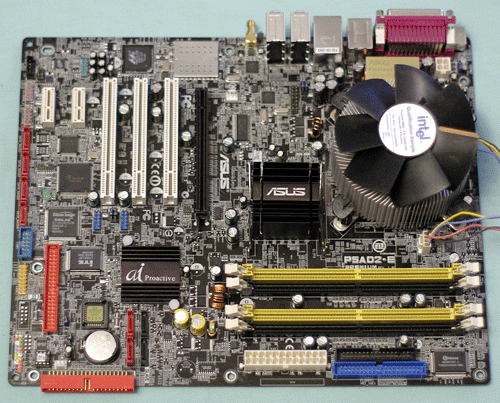FIRST LOOK: Asus P5AD2-E - 1066FSB & DDR2-711
by Wesley Fink on November 29, 2004 12:01 AM EST- Posted in
- Motherboards
Basic Features
The P5AD2 has one of the most complete selections of BIOS adjustments and board features that you will find on a Socket 775 motherboard. Therefore, Asus had no real need to include additional features on the P5AD2-E. The changes that were made are generally enhancements to existing options, like extending the chipset voltages and memory voltages and providing finer adjustments.| Asus P5AD2 Premium Motherboard Specifications | |
| CPU Interface | Socket 775 Pentium 4 (Prescott) |
| Chipset | Intel 925XE/ICH6R |
| FSB Speeds | 1066, 800 |
| Clock Speeds | 100MHz to 400MHz (in 1MHz increments) |
| PCI Speeds | To CPU, 33.33, Auto |
| DDR2 Speeds | Auto, 400, 533, 711 |
| Core Voltage | 1.4375V to 1.6125V in 0.0125V increments |
| DRAM Voltage | 1.80V to 2.20V in 0.05V increments |
| Chipset Voltage | Auto, 1.5V to 1.8V in 0.05V increments |
| FSB Termination Voltage | Auto, 1.2 to 1.5V in 0.05V increments |
| Memory Slots | Four 240-pin DDR2 Slots Dual-Channel Unbuffered Memory to 4GB |
| Expansion Slots | 1 PCIe x16 Slot 2 PCIe x1 slot 3 PCI Slots |
| Onboard SATA/IDE RAID | 4 SATA 150 drives by ICH6R Can be combined in RAID 0, 1, Intel Matrix PLUS 4 SATA 150 RAID by Sil3114R RAID 0, 1, 10, 5 |
| Onboard IDE | One Standard ATA100/66 by ICH6R (2 100/66/33 drives) Plus One IDE RAID by ITE 8212F (2 133/100/66, RAID 0, 1, JBOD) |
| Onboard USB 2.0/IEEE-1394 | 8 USB 2.0 ports 3 IEEE 1394b FireWire Ports by TI 1394b |
| Onboard LAN | 2 X Gigabit PCIe LAN Both by Marvel 88E8053 |
| Onboard Audio | CMedia CMI9880 (Intel HD) 8-Channel with SPDIF in/out |
| Wireless LAN | WiFi 802.11g Included |
| Tested BIOS | 1005 Beta 002 |
The one surprise in the Asus update to the P5AD2-E is the reduced range of CPU voltages. The original P5AD2 provides a vCore range from 1.4375V to 1.7875V, where the new -E version is just 1.4375V to 1.6125V. That's an adequate range, but it seems the wrong way to be going for top-line options. We hope that Asus will correct this in a BIOS update.

The Asus 925XE/925X boards are Premium boards - clearly top-of-the-line in every way. All of the Asus Proactive AI (Artificial Intelligence) features are included. This includes a special cooling plate on the bottom of the board in the CPU area that Asus calls Stack Cool.

Features are all but identical to the P5AD2, with both LAN ports powered by the new Marvel 88E8053 Ethernet controllers on the faster PCI Express bus. The P5AD2-E includes a complete WiFi setup with embedded (built into the board) 802.11g capabilities and an external antenna. You will also find 3 of the high-speed "b" versions of IEEE 1394 firewire, which promise double the speed of 1394a ports. Speed-step, a new Intel feature that allows the CPU to be downclocked to 14 for FSB/memory overclocking or cooler operation, is another Asus feature.
The premium C-Media CMI9880 codec supports the Intel High-Definition audio, with 8 channels and Dolby Digital Live technology support. The CMI9880 is the only audio solution we've seen that has a built-in Dolby AC3 encoder. The encoder can actually encode your digital audio into Dolby digital streams, which can be output to the SPDIF for Dolby Digital playback. The CMI9880 does this real-time for any digital audio in your system to feed Dolby Digital playback. Asus carries High-Definition (Azalia) audio further on the P5AD2-E and the P5AD2 than any other 925XE/925X board that we have seen.
The storage area is one area where the Asus stands above the crowd. All of the 925X/925XE boards support the ICH6R standard 4 SATA/1 IDE (2drives) configuration. The P5AD2/-E boards add 4 more SATA ports for a total of 8 SATA ports. They go even further by adding an ITE controller for 2 more IDE devices for a total of 4. Asus even includes a slot-mounted external SATA adapter for converting 2 SATA ports into external SATA ports for handling external SATA devices.
Asus is a manufacturer who pays close attention to the layout of their motherboards. We praised the layout of the P5AD2, and the P5AD2-E is exactly the same layout. Floppy and Hard Drive connectors are in the preferred upper right board-edge position, where they usually work best in most case designs. The 24-pin power connector and 4-pin 12V connector are both at board edges where they do not require being snaked across the CPU and restricting air flow. The 8 SATA ports are clustered at the lower right of the board (4 ports) and the bottom edge of the board (4 ports). The additional IDE connector is also near the bottom edge along with the headers for additional SATA and IEEE1384b ports.










34 Comments
View All Comments
dariush - Friday, February 4, 2005 - link
For Gaming, AMD is better but not all computer users are gamer, When Talking about about video encoding and stability (must important in critical cases) you see Intel says the last words.Wesley Fink - Thursday, December 2, 2004 - link
#32 - I would sincerely appreciate your reading the review before posting comments. Overclocking is covered on p.3 - which is actually titled "Overclocking and Stress Testing".Second, this is a First Look which is less detailed that a full review - the idea is to bring you more reviews quicker. We used to include a page explaining this, but I removed it this go-round because I assumed the idea was well-known by now. It appears I was should have kept the explanation page in the review.
Third, First Look uses PCMark2004 as a General Performance comparison. However, as I stated in Comment #18 the complete Winstones and media encoding do not provide additional information. However, they are already posted in Comment #18 and I'll repeat them:
"We did run a full suite of benchmarks for future comparisons, but nothing really changes.
925XE/3.46EE - 925X/3.6E - nF4/FX55 - Benchmark
34.1 - 34.4 - 39.3 - MM Content Creation 04
26.7 - 26.5 - 31.1 - Business Winstone 04
73.1 - 73.4 - 69.1 - AutoGK DivX 5.1.1".
Fourth, we use a standard setup to allow easier comparisons. Where standard 1024x768 benchmarks are CPU or GPU bound we do use AA and/or higher resolutions to allow valid comparions of motherboard performance. For example Comanche 4 is run at 1280x1024 with 4X AA because 1024x768 without AA reveals nothing about true performance. The "Score" bench for Aquamark 3 uses 4AA by default. We run the newest games at highest settings as detailed in the chart descriptions.
T8000 - Thursday, December 2, 2004 - link
If you talk about enthousiast options, overclocking is usually one of them. Still, no single overclocked CPU was included in the benchmarks.There was also no mention about the 925XE containing more options to keep PCI-E within spec during overclocking.
Besides, there where only gaming benchmarks with high end GPU's running at 1024x768 with no AA or AF, thus creating an unlikely scenario with performance numbers that do not reflect real world performance differences, even for those who just play games.
Who would even consider buying a $500 GF6800U to play only at settings that a $200 GF6600GT does with ease?
danidentity - Wednesday, December 1, 2004 - link
#28 - The Dolby Digital Live encoding on this board is functionally the same as SoundStorm on the NF2 boards. No PCI sound cards currently support Dolby Digital Live.cALIx - Tuesday, November 30, 2004 - link
Not to change the subject, but in this review, Doom 3 is listed as a dx9 game. Isnt D3 an opengl based game? If you open the console you can easily see all the gl_ extensions that are open. Also Hardocp always lists D3 as an opengl game when they benchmark with it. So I'm just wondering if someone could clear that up for me. I understand what they are individually, but i'm still confused as to how they work/dont work together...LoneWolf15 - Tuesday, November 30, 2004 - link
Ouch...my brand new $140 MSI K8N Neo 2 mainboard and I feel sorry for those who choose to shell $250-300 for this board. Not that it's a bad piece of hardware, not that Intel's high-end P4 chips are bad hardware either...but you can do better for far less money, so why would you pay this kind of cash? Especially when you could balance out your system with the money you've saved by upping your graphics card or opting for more RAM or a faster hard disk. Guess I'm just someone who doesn't see the point in buying a Jaguar when an Acura RSX-S would do what I want for less.tc2k04 - Tuesday, November 30, 2004 - link
I know i'm late, but,Did anybody else notice the talk about the audio solution, is this encoding comparable to the output of nforce2 boards? they say its a first for on the motherboard audio, can you buy seperate pci cards at reasonable prices which can do this?
i'm trying to get a sound solution that can output 2 channel audio in 5.1 through a digital out like my nforce2 onboard does. If this can do this, i might end up buying an intel.
Googer - Tuesday, November 30, 2004 - link
Intel's engineering DEPT takes orders From queer mac using Marketers.Googer - Tuesday, November 30, 2004 - link
#3 it works. I have done it. Super7 is like a Swiss Army Knife.TrogdorJW - Monday, November 29, 2004 - link
Hey Wes,Any chance of some OC tests and numbers from a standard Prescott core?
I'm wondering if a 2.8E has the potential to reach a 1066 FSB overclock.
(I'm also including hard returns due to the overly long link someone posted.)
As the 2MB cache alleviates some of the pressures of the FSB, a 1MB cache might benefit more.
Besides, if a 2.8E could actually OC well to 3.73 GHz and a 1066 FSB, that might be worthwhile!